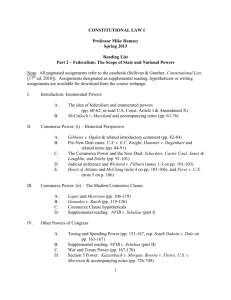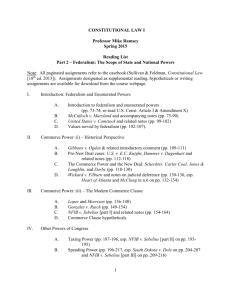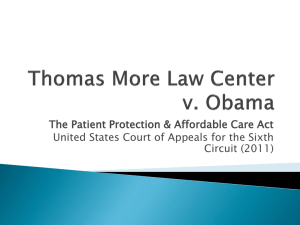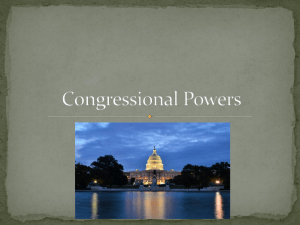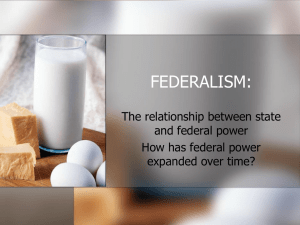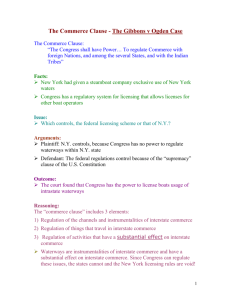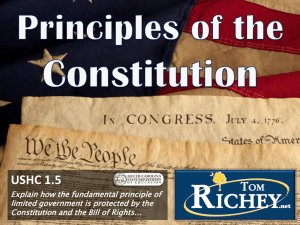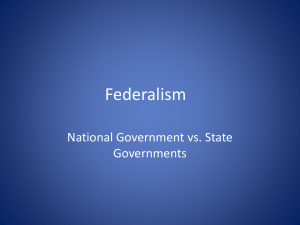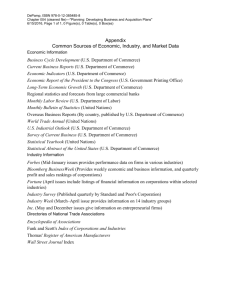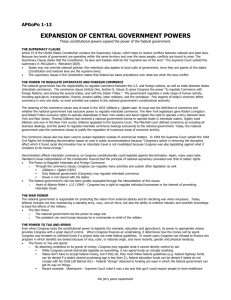Regulation and the US Intergovernmental System
advertisement
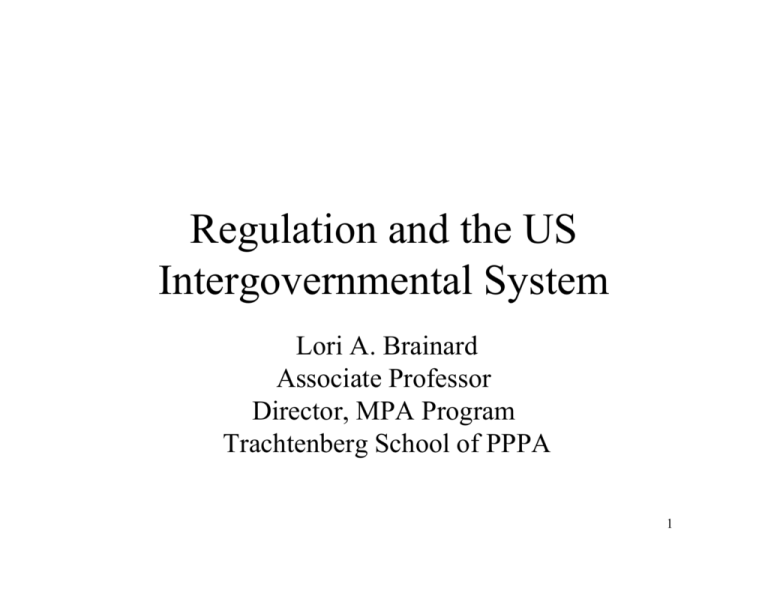
Regulation and the US Intergovernmental System Lori A. Brainard Associate Professor Director, MPA Program Trachtenberg School of PPPA 1 A Mosaic of Government Actors Nearly 90,000 governments in the U. S. • National Government • 50 State Governments plus the District of Columbia • 3000 County Government • 19,000 Municipalities • Remainder are special or more limited purpose governments 2 Elements of US Federalism • US Constitution contemplates two levels of governmental power, the national government and the states. There are conflicting views as to how power is divided. – Dual Sovereignty – Sovereignty of the People • Local governments are not mentioned in the Constitution. They are “creatures” of the state. 3 Federalism: A Legal Concept A form of government in which a union of states recognizes the sovereignty of a central authority while retaining certain residual powers form themselves. Characteristics: • • • • • Union of autonomous political entities Division of powers Operation of powers within geographic area Dual citizenship Supremacy of the National Government 4 Three Major Constitutional Questions 1. Under what circumstances can the federal government act? • Enumerated powers 2. Under what circumstances can state governments act? • • Reserved powers When is a state “preempted?” 3. Assuming that the national or state government is acting within its constitutionally assigned authority, can it impose obligations on the other “sovereign?” 5 Role of American Pragmatism • US ideology is pragmatism: realities influence our practice and that influence is their meaning for us. – William James: “Theories become instruments, not answers to enigmas, in which we can rest.” – Pragmatism as a philosophy dates back to Aristotle • Thus, we tend to decide things not based on “pristine” theories of federalism, but based on the realities of the situation. 6 History of American Federalism Many approaches to dividing up historical periods of US history; but a simplified approach is the following: 1. State-centered federal system 1789-1930. 2. Federal-centered system 1930-1980 3. Mixed, competitive system 1980-current – – Neither federal or state centered Fluid and constantly evolving 7 State-Centered Period 1789-1930 • Characterized as “Dual” federalism or “layer cake” • Small, relatively stable governments; by 1930 total spending just 10 percent of GDP---three fourths at the state-local level. • Federal government restricted both by finances and Supreme Court decisions. • States became responsible for most basic services, directly or through their local governments. 8 Federal-Centered Period 19301980 Four crises influenced the growth of the national government: 1. Crisis of totalitarianism 2. Crisis of industrialism 3. Crisis of racism 4. Crisis of confidence in state governments. 9 Federal-Centered Period 19301980 • Crisis-driven, the federal government gradually increased its power and responsibility. – 16th Amendment providing for a national income tax. (1913)—national fiscal power. – 15th Amendment provided for the regulation of states (1868)—eventually led to expansion of national police power. – “Commerce Clause”—interpreted more broadly beginning in 1930s (“Switch in time that saved nine.”) • By 1983 total government spending had grown to 33 percent of GDP, 24.3 percent at national level. 10 Mixed, Competitive Period 1980• Slower government growth (until recently). • More constrained/restrained federal government; more activist state governments. • Little restriction on the federal government’s regulatory power (except some recent court cases) • ?? Post 9-11 period; economic crisis?? 11 Dividing Regulatory Power • Hamiltonian vs. Jeffersonian debate in the nation’s early history. • McCulloch v. Maryland (1819), opinion by Chief Justice John Marshall: – Power of national government flows from the people, not the states; it is independent from the states. – Congress has power to incorporate a bank—”all laws which are necessary and proper” to its enumerated powers. – State cannot tax a national bank: “Constitution and the laws made in pursuance thereof are supreme; that they control the constitution and laws of the respective 12 States, and cannot be controlled by them…” State Powers • State’s derive their constitutional authority to regulate from their own governmental/constitutional structure—not from the federal government. – Concurrent Power • Federal government rarely interfered with the states in the exercise of their power unless a specific federal statute restricted the states from acting. 13 The Expanding Commerce Clause • Gibbons v. Ogden (1824), CJ Marshall: – Both national government and state governments can regulate commerce; however national government has preeminence over interstate commerce—enumerated power. – There are no limitations on the power of the federal government to regulate commerce. – Commerce between the states must mean commerce going into the state—not stop at the state’s border. • 110 years of sometimes conflicting interpretations of the extent of the commerce clause power. 14 • Hammer v. Dagenhart (1918)—Child Labor (5-4 decision): – Congress had no power to prohibit the interstate transportation of goods manufactured by child labor. – Congress was not regulating commerce but attempting to preempt states on its police powers 15 • Early New Deal cases were lost on 5-4 vote: – Railroad Retirement Board v. Alton Railroad (1935). – Schecter Poultry Corp. v. U.S. (1935). • After 1936 elections and FDR court-packing scheme, Court took a more pragmatic approach to New Deal legislation. – NLRB v. Jones & Laughlin Steel Corp (1937) (5-4) upheld authority of national government to regulate labor laws of a national company. – U.S. v. Darby (1941) upheld federal minimum wage laws which prohibited shipment of goods in interstate commerce not manufactured at specified wages. – Hodel v. Virginia Surface Mining and Reclamation Act (1981), Congress could regulate activities causing air and water pollution. 16 Commerce Clause as Limiting States Regulatory Power • Explicit preemption: Congress mandates something on the states or specifically overturns or outlaws state actions in a particular area. • Implicit preemption: Congress passes a comprehensive set of legislation that “occupies the field” and leaves no room for state action. 17 Limitations of Federal Power • Some recent Supreme Court decisions seem to want to limit the power of Congress under the Commerce Clause. – U.S. V. Lopez (1995) “Gun-Free School Zones Act of 1990.” (5-4—no finding regarding the effect upon interstate commerce of gun possession in a school zone.) – New York v. U.S. (1992) (6-3—federal government cannot appropriate a state function and compel action— though it can entice through grants, etc.) • Court seems to be returning to concept of Dual Sovereignty. 18 Regulations and the States • State variation in regulating nursing homes, environment, etc. • Federal role has largely been as a source of funds; however, it used those funds as a basis for requiring certain actions by the states. 19 Federal Regulatory Scheme Regulatory processes are a search for both fairness and efficiency. • Administrative Procedures Act of 1946 1. Notice of Inquiry: proposal for a rule 2. Notice of proposed rule – – Hearings; written comments Negotiated Rulemaking Act of 1990 3. Final Rulemaking 20 Office of Information and Regulatory Analysis (OIRA) • Important office within the Office of Management and Budget (OMB). • Applies and monitors a variety of Executive Orders: – Cost-benefit analysis – Impact on small business, the States, etc. 21 Modern Challenges to Current Regulator Scheme • The health care market—no longer local; clearly national and global in many respects. • Role of the internet in making available advice, drugs, etc. • Is the current state-dominated regulatory scheme outdated? • What are the limits of potential federal action? – Recent Case: Wyeth v. Levine (2009) 22 Regulatory Balancing Act • National Government can preempt, but does not always do so. Why? – Keeping role of federal government limited – Using states as prime enforcers of federal law; States assume “primacy.” • States are developing their own modern regulatory systems. – Can they keep us with technology? 23

